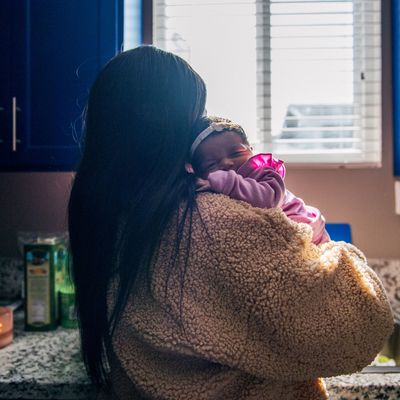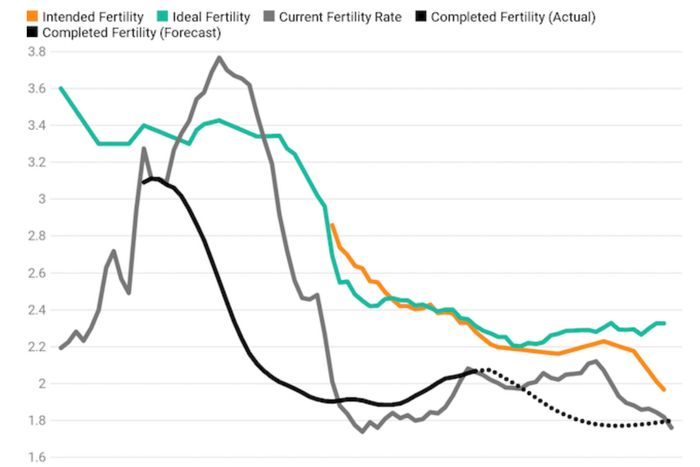
For much of the past year, couples across the United States had little to do but each other. Lockdown orders forced many Americans into almost constant contact with their significant others, while forbidding a hefty percentage of our society’s non-carnal forms of entertainment. If this led to a surge in gross domestic lovemaking, it did not translate into more birth certificates.
In 2020, America’s birth rate declined at its fastest pace in 50 years, the federal government revealed Wednesday. That historic drop came on top of five preceding annual declines, leaving the nation’s birth rate at its lowest point in over a century. In 2020, there were 46 births for every 1,000 women in the United States; in the early 1960s, that figure was closer to 90. At the same time, the pandemic depressed immigration inflows and drastically increased annual deaths. As a result, America’s population over the past decade grew at the second-slowest rate on record.
Women in the U.S. (and every other developed country) have long been delaying childbirth until later in life. While lowering overall fertility, this phenomenon had been driving up rates of childbearing among women in their late 30s and early 40s. But in 2020, even these cohorts yielded fertility declines.
Which isn’t terribly surprising. Mass death events tend to be followed by reductions in births nine months later. What’s more, in most parts of the country, the pandemic shuttered schools and day cares, massively increasing the burdens of child-rearing for working parents. Whatever the reason, COVID does appear to have directly exacerbated 2020’s fertility decline. America’s nursery wards were emptiest in the final months of the year, when newborns conceived during the pandemic came due: Births declined by 4 percent in 2020 as a whole, but December 2020 saw 8 percent fewer births than December 2019 had.
COVID’s impact on American fertility could linger long after the pandemic has passed. When the Great Recession triggered a fall in births in 2009, many observers expected the national birth rate to rebound once the economic crisis was over, as it had after the worst years of the Great Depression. But this did not happen. Instead, the financial crisis appeared to accelerate the underlying long-term trend of people choosing to have smaller families or not have children at all.
From one angle, America’s falling fertility rate can be seen as a measure of social progress. In nations across the globe, women’s attainment of social power and access to contraception has coincided with declining birth rates. Given the formal right to fully participate in economic life and the tools to control pregnancy, relatively few women want to birth more than four children. On the other hand, survey data suggests that, in the aggregate, American women are having fewer children than they say they want (i.e., their “ideal” preference) and fewer children than they’d intended to have earlier in life. Lyman Stone of the Institute for Family Studies illustrates this reality:
The most commonly cited reason for this gap between maternal desire and reality is financial constraint. Theoretically, socializing the costs of child-rearing and lowering the economic disincentives of parenthood could simultaneously give women more control over their reproductive lives (by making it materially possible for personal desire alone to dictate family size), while also increasing birth rates. And to the extent that gender equality and individual freedom can be reconciled with higher birth rates, there is a case for regarding the latter as a social good.
America’s fertility rate is now well below replacement levels. This puts the nation on a path to an inverted age structure, in which the number of elderly Americans far exceeds the prime-age population available to support and care for them. Since the United States remains an attractive destination for immigrants, it can avert demographic — and thus, economic and geopolitical — decline by embracing higher rates of immigration. Yet this solution to underpopulation is both politically difficult to realize and, in the long term, unsustainable. After all, birth rates are falling worldwide. Twenty-three nations are poised to see their populations halve by 2100, while the global fertility rate is projected to drop below 1.7 children per woman.
To the extent that public policy can avert long-term demographic decline, it can only do so by making it easier for people to have as many children as they want. This said, existing models of “pro-natal” welfare policies have been largely unsuccessful. Even nations like Sweden and Singapore, which have adopted exceptionally generous pro-natal social policies, have had their birth rates fall below replacement level. One interpretation of such failures is that in meritocratic, capitalist societies, middle-class expectations for the amount of time and financial investment a child requires have grown so high, only a radical economic reordering can make larger families feel broadly attainable. Another potential interpretation is that the gap between desired and actual family size in the U.S. is smaller than it appears, and so the gap is unlikely to decline, irrespective of social policy. As the U.S. grows more secular, American women’s reproductive ambitions may approach the reported preference of their peers in Sweden.
A shrinking global population will present humanity with many unprecedented social, political, and economic challenges. But it is not obvious (at least, to me) that such challenges cannot be adequately managed. With sufficient advances in automation and economic equality, sustaining a large elderly population with a small prime-age one may not be as daunting a task as it now appears. And although the relationship between population size and ecological sustainability is not as straightforward as neo-Malthusians suggest, it’s nevertheless true that population decline will likely mitigate some pressures on the biosphere.
Regardless, if the global decline in fertility continues, its consequences will shape human life in 2100 about as thoroughly as the COVID pandemic did in 2020.































